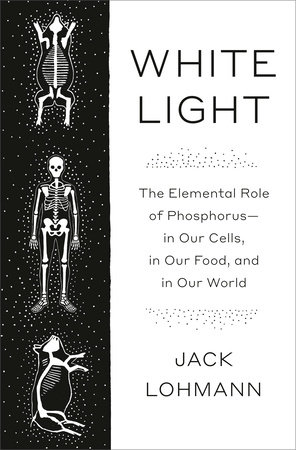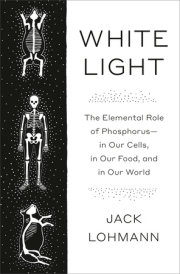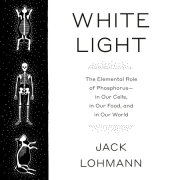1
Sea of Fires
There would be no life without constant death. The bodies of our forebears came to form the base of our lives today. All of us are made of accumulated parts worn down and enlivened by billions of years of excess and limitation. Our bodies are living remnants of the past. We are all recycled—our food is dead; it was grown in soil made rich by decay. When we die, gorged and wealthy, our purpose is to fertilize the ground. The waste we create, and the waste we someday will become, exists in balance with the earth.
The world warms, and life surges. Profusions of species occupy the earth; they drink its water. They arrive in heat-driven bursts, and they flourish most in places where residues of past life can collect. Along some coastlines, upwelling waters pull nutrients from the cold seafloor. Sunlight reaches those substances on the surface, and life blooms. Elsewhere, inland seas, called into existence by warmer weather and melted glaciers, create closed circuits of growth and accumulation. Deltas, where rivers enter open water, collect the sediments that the rivers carried all along their paths. Some islands, situated far out to sea, serve as collection points for life and its excrements. In these ecosystems, life builds upon itself, and exceptional productivity ensues.
Something changes on the earth. The temperature cools, the continents shift, the oceans drop their nutrients somewhere else. The closed circuit opens, and bodies are covered in sediment. They settle and condense, growing firmer under pressure from above. Chemicals dance—crystals form. Metals dissolved in seawater are absorbed by what remains, and the crystals fit more cleanly with one another. They are stable, and then they change again. Storms and tides churn the seafloor, washing away some materials and bringing others near. Years pass, and the continents move again, pushing compact crystals out of the water. Settled and churned, scarce and hidden, buried beneath layers of geology, this collection of reworked matter is a literal crystallization of life. It exists in a thousand different places and a thousand different forms, holding contents of silent value. This is phosphate rock.
Phosphate, underneath the surface, holds the power of life itself. That power is exerted through the forces that shape the physical world. All of life is controlled by geology. Through the steady, cyclical accumulation and release of phosphate, unseen forces determine the biological productivity of the earth. When the rate of erosion increases—when more phosphate is added to the system—the world is overrun by life. When erosion decreases, or a large expanse of phosphate is deposited as rock, the system loses phosphate, and life’s sum total drops. Phosphate exists within the confines of a natural order, a deliberate cycle of destruction and creation. It travels slowly between life and rock, and its journey defines the contours of the life that can exist on earth. It is an adherence to the plodding of geologic time, but with a twist: some hidden crystals, in recent years, have begun to travel at a different pace, in a different direction, along a different path. This new path began along the coast of England, at a time when the countryside—the sloping plain of Suffolk in particular—was on fire.
The arsonists were everywhere. They were living in the villages and working in the fields. They came out in the dark of night and crept onto the lands of wealthy farmers and lit up their barns and sheds, their threshers and carts, their haystacks. They killed their animals. They were rageful—and they were poor.
England’s wealth was growing as the dignity of the poor declined. Land was privatized, child labor thrived, and the poorhouse system punished society’s weakest members. In East Anglia, the region made up of Norfolk and Suffolk, the situation was particularly dire. The textile economy had declined in response to London’s growing industry, and the workers were left reliant on agriculture. But farmwork was seasonal and unsteady, and it was controlled by landowners and by farmers, the powerful occupiers of the land. Population grew, wages declined, the poor grew poorer, and the land became weaker. Then came 1843. A dramatic hailstorm destroyed the crops in August, and a terrible drought arrived the following year. Little grew, and the laborers could not work. People could not pay for food; there were hunger riots. And as they starved, they watched shipments of food going elsewhere, although the landowners continued to make a profit from their crops.
In 1843 and 1844, more than six hundred fires were set across England. Arson attacks were carried out against unjust magistrates and landowners who evicted tenants. Fires were set at workhouses, at jails, at taverns, and at shops. By far the most common targets were the farmers whose decisions had consigned the laboring classes to desperation and shortage. Entire properties were destroyed. “The year 1844 was one of intense alarm to the owners and occupiers of farms,” the historian John Glyde wrote in 1856. “Fires were of almost nightly occurrence during the long evenings. The occupiers of land lived in a state of nervous excitement, looking about their premises every night before retiring to rest, apprehensive of their crops being destroyed by the match of the prowling incendiary.” “Even among some of the poor the fear took on almost apocalyptic proportions. Two preachers, Winter and Burgis, tramped the countryside warning the people the world was about to end in one great catastrophic fire,” the historian John Archer wrote. “The end of the world was fixed for 21 March 1844.”
At the center of the fires was the village of Hitcham, and at the height of the flames Hitcham was led by a famous man. The naturalist John Stevens Henslow, appointed rector seven years before the world’s forecasted end, was an academic of national renown who worked as a professor at the University of Cambridge. He was first a botanist and then a mineralogist, a researcher whose focus was on the natural world. When Charles Darwin came to Cambridge in 1828, Henslow had taught him botany. At the time, Darwin was struggling. He felt disconnected from his studies and had trouble keeping up at Cambridge. During those years, Henslow and Darwin embarked upon a series of adventures that inspired Darwin with a sense of the boundlessness of the natural world. The two went searching for flowers in the countryside and traversed the swampy fenland north of the city. They made aborted plans to visit the Canary Islands. Henslow saw in Darwin early traces of the mind that would revolutionize scientific thought. When the HMS Beagle was launched in 1820, it was Henslow who ensured that Darwin was aboard—although Henslow himself had received the initial invitation to go. While the Beagle was away, Darwin and Henslow communicated extensively, and Darwin had his trove of specimens, collected from around the world, delivered to Henslow in England for safekeeping. Henslow, Darwin said, had changed his life.
The same year Darwin published The Voyage of the Beagle, Henslow moved to Hitcham for good. It may have seemed a surprising change, but the 1830s were a difficult time for the university, and the Crown living at Hitcham paid far more than a Cambridge professorship did. Henslow scaled back his academic duties, and by 1839 he was living in the countryside and running the parish. The conditions he found there shocked him. Hitcham had long been a place of discontent and disruption. In 1820, the parsonage had been set aflame in response to a denial of poor assistance for a sizable number of residents. Seven years into his rectorship, the harvest had failed, and the violence had worsened. “We have almost nightly fires about the neighborhood,” Henslow wrote in 1844, “and as I was lecturing at Hadleigh on Wednesday, a cry of fire interrupted and spoilt all.” In April 1844, a correspondent from The Times of London reported an epidemic of nightly crime in Hitcham, a scourge that included frequent fires and a number of break-ins at the church, the corn mill, and many shops. “Scarce a night passed during the winter months, at one period, but the sky was lit up with incendiary fires,” Leonard Jenyns, Henslow’s brother-in-law, would write. “No farmer felt himself secure.”
The crux of the problem in the countryside lay in the uneven production and distribution of food. In a decade of want, during a century of growth and unrest, the prospect of food shortage loomed large in the minds of Henslow’s parishioners. Some of this had to do with what was happening across the Irish Sea. A potato blight had first appeared in 1845, brought over from America, and quickly spread through Ireland, where widespread famine took hold. Even though the Irish grew a wide array of crops, the potato was the staple of the diets of the poor. The rich maintained a profitable export trade of other crops, and the government declined to intervene. A million people died of hunger. The threat of famine in England presented similar concerns. Facing down the landed interests of Hitcham—the landowners and the farmers—Henslow used his role as rector to press for social change, sermonizing about Christian charity and making overt appeals for financial assistance for his schemes for the poor. He advocated for higher-quality education and for more recreational opportunities for the working class, and he founded a school, funded through his own salary, for the children of laborers. He spoke openly of the need for farmers to respect the rights of workers—a kindness but also a necessity as those abused workers burned the countryside in despair.
Henslow felt that science and social well-being were inextricably intertwined; curiosity and scientific investigation, he believed, could improve the lives of common people. An influx of agricultural science would solve food shortages, quelling unrest. He fashioned a series of experiments that involved dozens of farmers from around the parish working to raise yields through the use of natural fertilizers. He lectured on farming methods and soil fertility and published fifteen Letters to the Farmers of Suffolk in a local newspaper. He gave lessons on manuring, taught botany to children, and disseminated scientific information among his parishioners, many of whom were illiterate. For those who could read or were learning to do so, he founded a lending library, instituting adult literacy classes shortly after. “The art of husbandry should be converted into the science of agriculture,” Henslow was known to say.
A scientist walking through his parish, Henslow was often seen investigating the rocks that made the roadways or the soil that made the fields. Rector and also magistrate, he remained, over time, a naturalist. Like many scientists of his day, he had received broad but scattered training in various natural fields. He had been drawn to science from a young age, exploding gunpowder, modeling caterpillars, and collecting fungus and flowers at home. At school in London, he was entranced by the idea of travel. At Cambridge, as an undergraduate, he studied mathematics. He participated in a geological survey of the Welsh island of Anglesey, cataloged a vast collection of British plants, and studied the formation of mineral crystals. Among his most lasting contributions was the Cambridge Botanic Garden, which he managed and moved to a new location, nearly eight times larger, devotedly collecting specimens that made the garden a botanical masterpiece.
In 1842, during a holiday in Felixstowe, Henslow took a walk along the North Sea coast of Suffolk, and he saw stones and fossils within layers of clay, all of it buffeted by waves. Among those pieces, he found a rock that would launch the modern phosphate industry.
One hundred and seventy-nine years after Henslow’s walk, Neil Davies, a sedimentary geologist at the University of Cambridge, is standing at the base of a cliff layered with red sand, the North Sea at his back, holding up a pound’s worth of bulbous, dark material that might be phosphate. “It could have been some kind of nodule at the time—it’s got that kind of cracking inside it. Unlike the stuff in the Greensand and the Gault, you don’t often get to see what these things are, just because, after they were deposited, once they were fossilized, they were dragged out and rolled back and forth repeatedly by waves.” Davies and I are searching for phosphate in the cliff—the Bawdsey Cliff—where the modern phosphate industry began, where the wastes of life and the promises of death lost their balance with each other, where humanity upended the limits of nature and launched itself into a period of interminable growth.
We are here to see the Red Crag, a layer of sandy strata that formed 2 million years ago. The Red Crag sits directly upon the London Clay. The Clay—thick, blue gray—formed between 56 and 49 million years ago, when eastern England was submerged in a vast, warm, life-enriching sea. We are standing on the London Clay, looking at the Red Crag; the border between the two layers lies roughly at our knees. “If you were to take out that block of clay there and wash it down, you would find a handful of pieces of phosphate, a handful of nice fossils inside there. But because they’re so randomly scattered throughout it, and because the clay is so resistant, it’s not like you see them sticking out very often,” Davies says, as I reach to break off a chunk of damp material. “Clay is a cohesive sediment. The particles are so small that they all are chemically attracted to one another—plus, of course, getting wet, they basically become one agglomeration of particles, whereas the sand is sand: it just falls apart in your hands as you touch it.”
What is known is this: the London Clay Sea was an expansive body of water that once, long ago, extended from the middle of England to the plains of Poland and north to Scandinavia. Covering much of northern Europe, the sea was isolated, sharing characteristics with the Mediterranean Sea of today. In a series of successive waves of sedimentation that occurred over a period of 7 million years, the London Clay Sea deposited a layer of material that is, in some places, five hundred feet thick. Because of the features of the sea—the warmth, the productivity, the occasionally oxygenated bottom—fossils were preserved, and phosphate formed. The clay preserved the life that had inhabited the surface for millions of years.
There is a gap in the sedimentary record that spans the distance between the end of the London Clay and the beginning of the Crag, an interval of time equal to about 45 million years. The lack of sediments suggests that, during this time, the sea receded, and the top of the London Clay became dry land. It stayed that way until a little over 5 million years ago. At that time, the earth warmed, and the sea came back over the land. The resulting series of resurgences of water created a sedimentary layer collectively known as the Crag Group. Four sedimentary deposits were made over a 4 million year period: Coralline, Red, Wroxham, and Norwich. As they stand today, each deposit represents, at most, several dozen meters’ thickness of collected sediments. Torn away by glaciers and weathering, they are not continuous layers across the surface.
Copyright © 2025 by Jack Lohmann. All rights reserved. No part of this excerpt may be reproduced or reprinted without permission in writing from the publisher.






